Palakorn Achananuparp
Effects of Theory of Mind and Prosocial Beliefs on Steering Human-Aligned Behaviors of LLMs in Ultimatum Games
May 30, 2025Abstract:Large Language Models (LLMs) have shown potential in simulating human behaviors and performing theory-of-mind (ToM) reasoning, a crucial skill for complex social interactions. In this study, we investigate the role of ToM reasoning in aligning agentic behaviors with human norms in negotiation tasks, using the ultimatum game as a controlled environment. We initialized LLM agents with different prosocial beliefs (including Greedy, Fair, and Selfless) and reasoning methods like chain-of-thought (CoT) and varying ToM levels, and examined their decision-making processes across diverse LLMs, including reasoning models like o3-mini and DeepSeek-R1 Distilled Qwen 32B. Results from 2,700 simulations indicated that ToM reasoning enhances behavior alignment, decision-making consistency, and negotiation outcomes. Consistent with previous findings, reasoning models exhibit limited capability compared to models with ToM reasoning, different roles of the game benefits with different orders of ToM reasoning. Our findings contribute to the understanding of ToM's role in enhancing human-AI interaction and cooperative decision-making. The code used for our experiments can be found at https://github.com/Stealth-py/UltimatumToM.
A Multi-Stage Framework with Taxonomy-Guided Reasoning for Occupation Classification Using Large Language Models
Mar 17, 2025Abstract:Automatically annotating job data with standardized occupations from taxonomies, known as occupation classification, is crucial for labor market analysis. However, this task is often hindered by data scarcity and the challenges of manual annotations. While large language models (LLMs) hold promise due to their extensive world knowledge and in-context learning capabilities, their effectiveness depends on their knowledge of occupational taxonomies, which remains unclear. In this study, we assess the ability of LLMs to generate precise taxonomic entities from taxonomy, highlighting their limitations. To address these challenges, we propose a multi-stage framework consisting of inference, retrieval, and reranking stages, which integrates taxonomy-guided reasoning examples to enhance performance by aligning outputs with taxonomic knowledge. Evaluations on a large-scale dataset show significant improvements in classification accuracy. Furthermore, we demonstrate the framework's adaptability for multi-label skill classification. Our results indicate that the framework outperforms existing LLM-based methods, offering a practical and scalable solution for occupation classification and related tasks across LLMs.
Consistent Client Simulation for Motivational Interviewing-based Counseling
Feb 05, 2025Abstract:Simulating human clients in mental health counseling is crucial for training and evaluating counselors (both human or simulated) in a scalable manner. Nevertheless, past research on client simulation did not focus on complex conversation tasks such as mental health counseling. In these tasks, the challenge is to ensure that the client's actions (i.e., interactions with the counselor) are consistent with with its stipulated profiles and negative behavior settings. In this paper, we propose a novel framework that supports consistent client simulation for mental health counseling. Our framework tracks the mental state of a simulated client, controls its state transitions, and generates for each state behaviors consistent with the client's motivation, beliefs, preferred plan to change, and receptivity. By varying the client profile and receptivity, we demonstrate that consistent simulated clients for different counseling scenarios can be effectively created. Both our automatic and expert evaluations on the generated counseling sessions also show that our client simulation method achieves higher consistency than previous methods.
CAMI: A Counselor Agent Supporting Motivational Interviewing through State Inference and Topic Exploration
Feb 05, 2025Abstract:Conversational counselor agents have become essential tools for addressing the rising demand for scalable and accessible mental health support. This paper introduces CAMI, a novel automated counselor agent grounded in Motivational Interviewing (MI) -- a client-centered counseling approach designed to address ambivalence and facilitate behavior change. CAMI employs a novel STAR framework, consisting of client's state inference, motivation topic exploration, and response generation modules, leveraging large language models (LLMs). These components work together to evoke change talk, aligning with MI principles and improving counseling outcomes for clients from diverse backgrounds. We evaluate CAMI's performance through both automated and manual evaluations, utilizing simulated clients to assess MI skill competency, client's state inference accuracy, topic exploration proficiency, and overall counseling success. Results show that CAMI not only outperforms several state-of-the-art methods but also shows more realistic counselor-like behavior. Additionally, our ablation study underscores the critical roles of state inference and topic exploration in achieving this performance.
Speaker Verification in Agent-Generated Conversations
May 16, 2024Abstract:The recent success of large language models (LLMs) has attracted widespread interest to develop role-playing conversational agents personalized to the characteristics and styles of different speakers to enhance their abilities to perform both general and special purpose dialogue tasks. However, the ability to personalize the generated utterances to speakers, whether conducted by human or LLM, has not been well studied. To bridge this gap, our study introduces a novel evaluation challenge: speaker verification in agent-generated conversations, which aimed to verify whether two sets of utterances originate from the same speaker. To this end, we assemble a large dataset collection encompassing thousands of speakers and their utterances. We also develop and evaluate speaker verification models under experiment setups. We further utilize the speaker verification models to evaluate the personalization abilities of LLM-based role-playing models. Comprehensive experiments suggest that the current role-playing models fail in accurately mimicking speakers, primarily due to their inherent linguistic characteristics.
Transforming Facial Weight of Real Images by Editing Latent Space of StyleGAN
Nov 05, 2020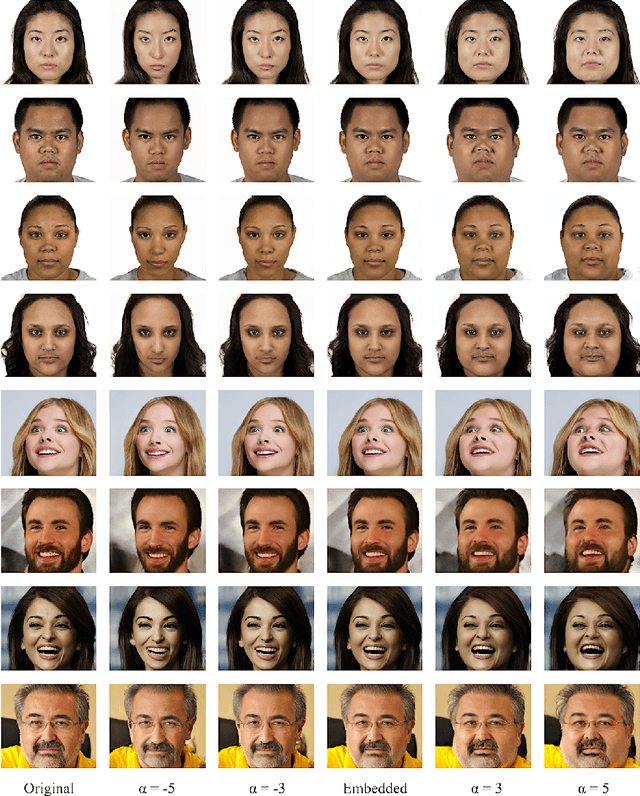
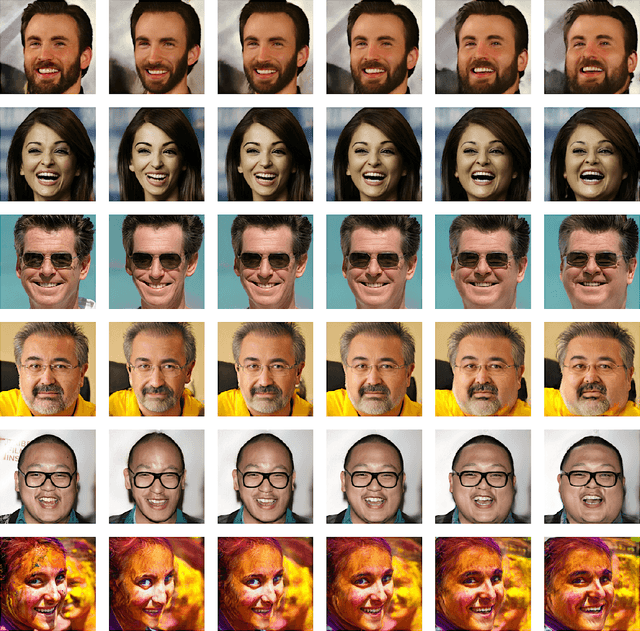
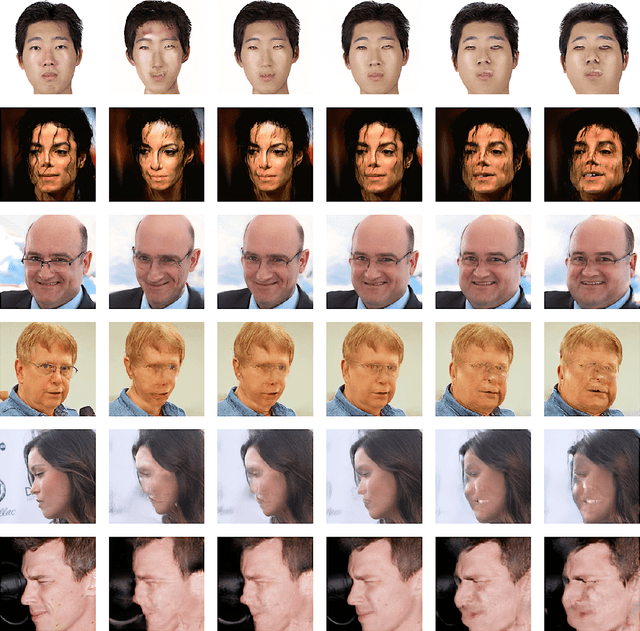
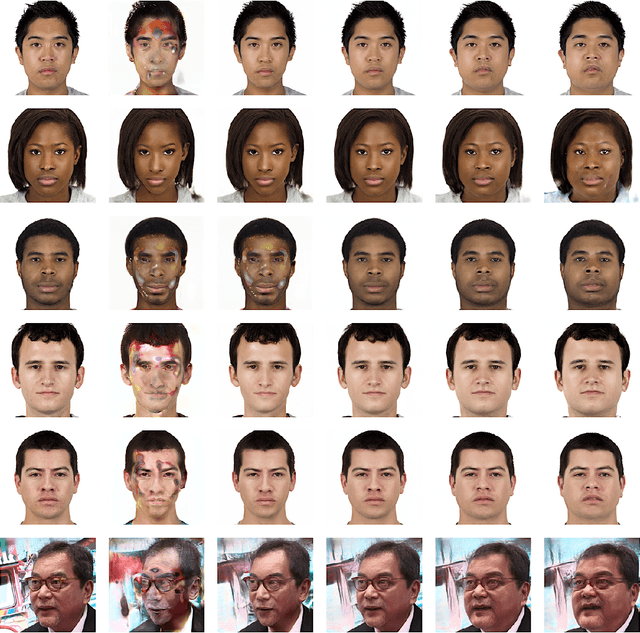
Abstract:We present an invert-and-edit framework to automatically transform facial weight of an input face image to look thinner or heavier by leveraging semantic facial attributes encoded in the latent space of Generative Adversarial Networks (GANs). Using a pre-trained StyleGAN as the underlying generator, we first employ an optimization-based embedding method to invert the input image into the StyleGAN latent space. Then, we identify the facial-weight attribute direction in the latent space via supervised learning and edit the inverted latent code by moving it positively or negatively along the extracted feature axis. Our framework is empirically shown to produce high-quality and realistic facial-weight transformations without requiring training GANs with a large amount of labeled face images from scratch. Ultimately, our framework can be utilized as part of an intervention to motivate individuals to make healthier food choices by visualizing the future impacts of their behavior on appearance.
Cross-Modal Food Retrieval: Learning a Joint Embedding of Food Images and Recipes with Semantic Consistency and Attention Mechanism
Mar 09, 2020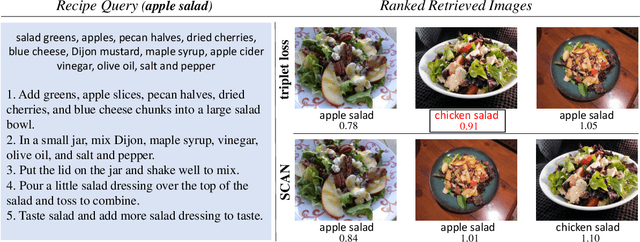
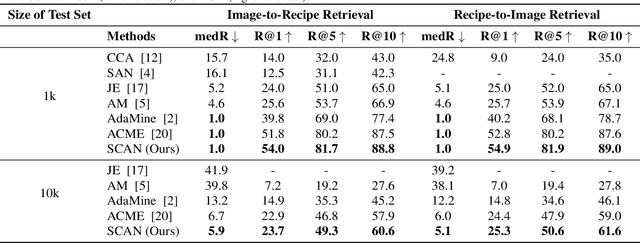
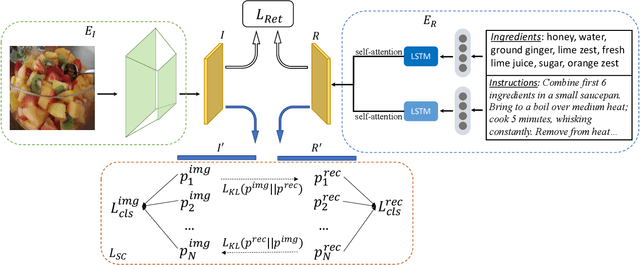
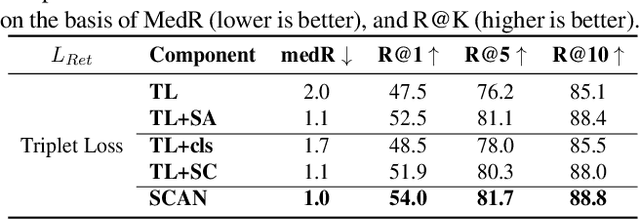
Abstract:Cross-modal food retrieval is an important task to perform analysis of food-related information, such as food images and cooking recipes. The goal is to learn an embedding of images and recipes in a common feature space, so that precise matching can be realized. Compared with existing cross-modal retrieval approaches, two major challenges in this specific problem are: 1) the large intra-class variance across cross-modal food data; and 2) the difficulties in obtaining discriminative recipe representations. To address these problems, we propose Semantic-Consistent and Attention-based Networks (SCAN), which regularize the embeddings of the two modalities by aligning output semantic probabilities. In addition, we exploit self-attention mechanism to improve the embedding of recipes. We evaluate the performance of the proposed method on the large-scale Recipe1M dataset, and the result shows that it outperforms the state-of-the-art.
RecipeGPT: Generative Pre-training Based Cooking Recipe Generation and Evaluation System
Mar 05, 2020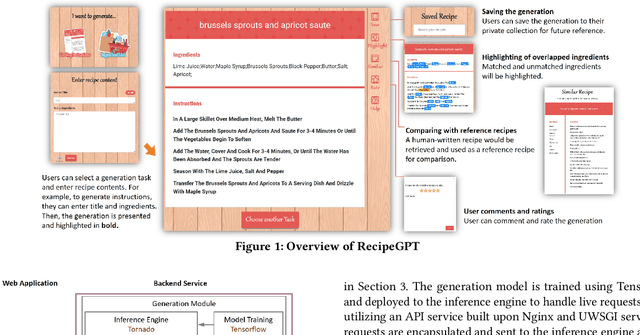
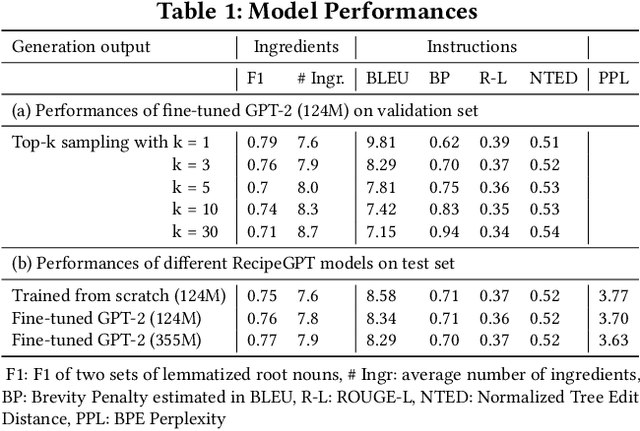
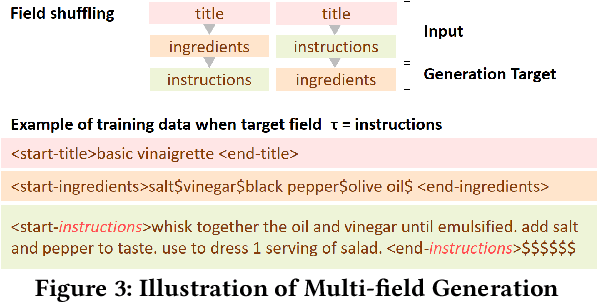
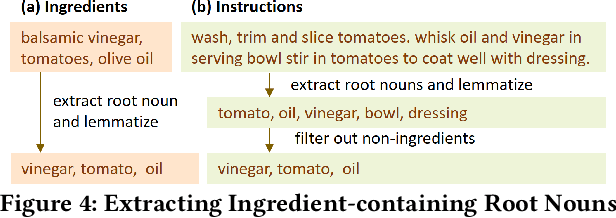
Abstract:Interests in the automatic generation of cooking recipes have been growing steadily over the past few years thanks to a large amount of online cooking recipes. We present RecipeGPT, a novel online recipe generation and evaluation system. The system provides two modes of text generations: (1) instruction generation from given recipe title and ingredients; and (2) ingredient generation from recipe title and cooking instructions. Its back-end text generation module comprises a generative pre-trained language model GPT-2 fine-tuned on a large cooking recipe dataset. Moreover, the recipe evaluation module allows the users to conveniently inspect the quality of the generated recipe contents and store the results for future reference. RecipeGPT can be accessed online at https://recipegpt.org/.
FoodAI: Food Image Recognition via Deep Learning for Smart Food Logging
Sep 26, 2019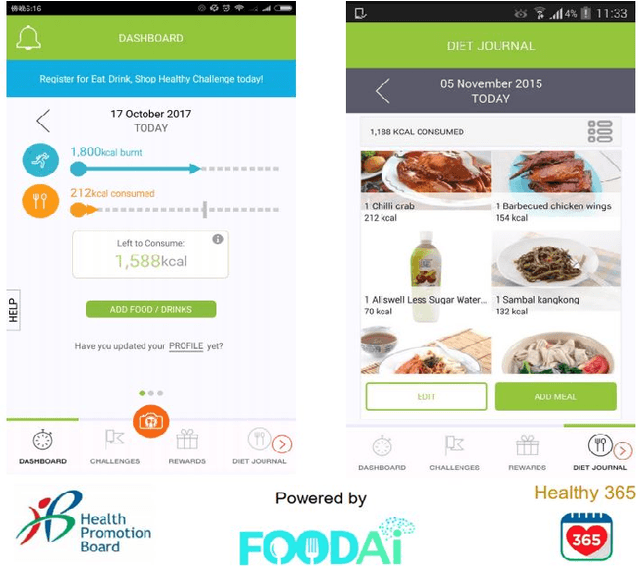



Abstract:An important aspect of health monitoring is effective logging of food consumption. This can help management of diet-related diseases like obesity, diabetes, and even cardiovascular diseases. Moreover, food logging can help fitness enthusiasts, and people who wanting to achieve a target weight. However, food-logging is cumbersome, and requires not only taking additional effort to note down the food item consumed regularly, but also sufficient knowledge of the food item consumed (which is difficult due to the availability of a wide variety of cuisines). With increasing reliance on smart devices, we exploit the convenience offered through the use of smart phones and propose a smart-food logging system: FoodAI, which offers state-of-the-art deep-learning based image recognition capabilities. FoodAI has been developed in Singapore and is particularly focused on food items commonly consumed in Singapore. FoodAI models were trained on a corpus of 400,000 food images from 756 different classes. In this paper we present extensive analysis and insights into the development of this system. FoodAI has been deployed as an API service and is one of the components powering Healthy 365, a mobile app developed by Singapore's Heath Promotion Board. We have over 100 registered organizations (universities, companies, start-ups) subscribing to this service and actively receive several API requests a day. FoodAI has made food logging convenient, aiding smart consumption and a healthy lifestyle.
Estimating Glycemic Impact of Cooking Recipes via Online Crowdsourcing and Machine Learning
Sep 17, 2019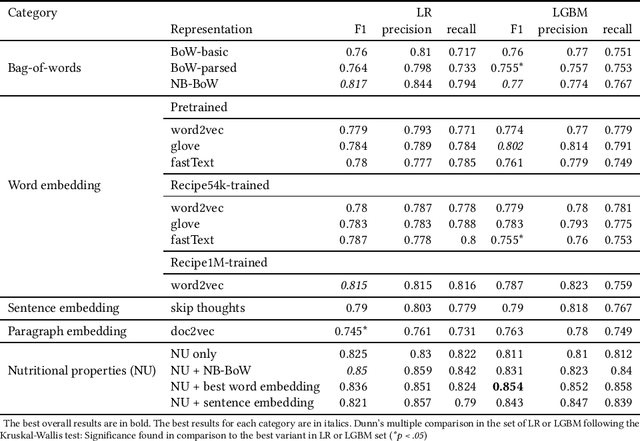
Abstract:Consumption of diets with low glycemic impact is highly recommended for diabetics and pre-diabetics as it helps maintain their blood glucose levels. However, laboratory analysis of dietary glycemic potency is time-consuming and expensive. In this paper, we explore a data-driven approach utilizing online crowdsourcing and machine learning to estimate the glycemic impact of cooking recipes. We show that a commonly used healthiness metric may not always be effective in determining recipes suitable for diabetics, thus emphasizing the importance of the glycemic-impact estimation task. Our best classification model, trained on nutritional and crowdsourced data obtained from Amazon Mechanical Turk (AMT), can accurately identify recipes which are unhealthful for diabetics.
 Add to Chrome
Add to Chrome Add to Firefox
Add to Firefox Add to Edge
Add to Edge